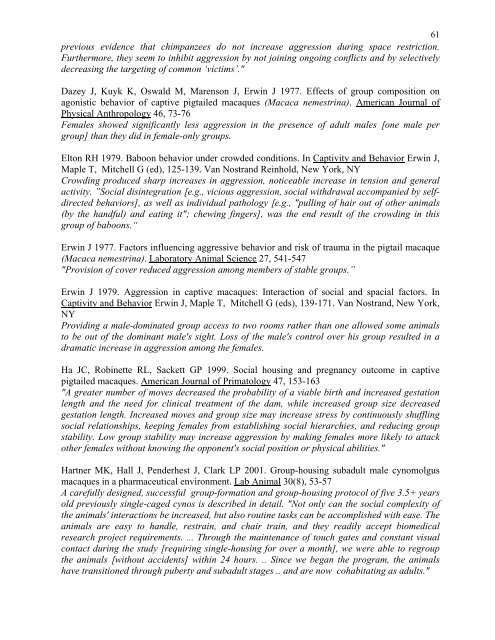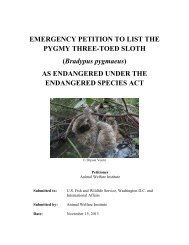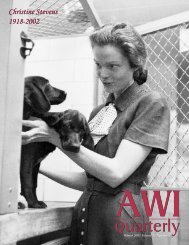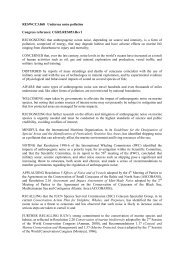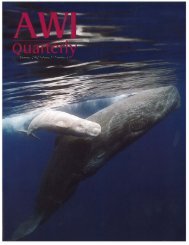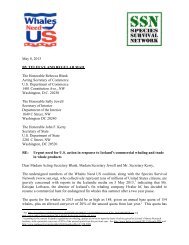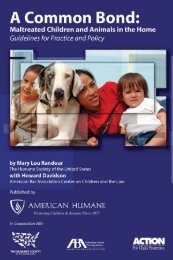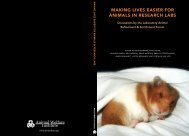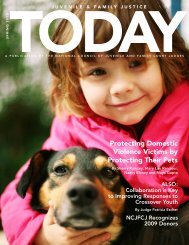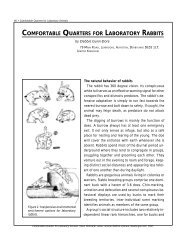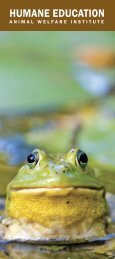61previous evidence that chimpanzees do not increase aggression during space restriction.Furthermore, they seem to inhibit aggression by not joining ongoing conflicts a<strong>nd</strong> by selectivelydecreasing the targeting of common ‘victims’."Dazey J, Kuyk K, Oswald M, Marenson J, Erwin J 1977. Effects of group composition onagonistic behavior of captive pigtailed macaques (Macaca nemestrina). American Journal ofPhysical Anthropology 46, 73-76Females showed significantly less aggression in the presence of adult males [one male pergroup] than they did in female-only groups.Elton RH 1979. Baboon behavior u<strong>nd</strong>er crowded co<strong>nd</strong>itions. In Captivity a<strong>nd</strong> Behavior Erwin J,Maple T, Mitchell G (ed), 125-139. Van Nostra<strong>nd</strong> <strong>Re</strong>inhold, New York, NYCrowding produced sharp increases in aggression, noticeable increase in tension a<strong>nd</strong> generalactivity. ”Social disintegration [e.g., vicious aggression, social withdrawal accompanied by selfdirectedbehaviors], as well as i<strong>nd</strong>ividual pathology [e.g., "pulling of hair out of other animals(by the ha<strong>nd</strong>ful) a<strong>nd</strong> eating it"; chewing fingers], was the e<strong>nd</strong> result of the crowding in thisgroup of baboons.“Erwin J 1977. Factors influencing aggressive behavior a<strong>nd</strong> risk of trauma in the pigtail macaque(Macaca nemestrina). Laboratory Animal Science 27, 541-547"Provision of cover reduced aggression among members of stable groups.”Erwin J 1979. Aggression in captive macaques: Interaction of social a<strong>nd</strong> spacial factors. InCaptivity a<strong>nd</strong> Behavior Erwin J, Maple T, Mitchell G (eds), 139-171. Van Nostra<strong>nd</strong>, New York,NYProviding a male-dominated group access to two rooms rather than one allowed some animalsto be out of the dominant male's sight. Loss of the male's control over his group resulted in adramatic increase in aggression among the females.Ha JC, Robinette RL, Sackett GP 1999. Social housing a<strong>nd</strong> pregnancy outcome in captivepigtailed macaques. American Journal of <strong>Prima</strong>tology 47, 153-163"A greater number of moves decreased the probability of a viable birth a<strong>nd</strong> increased gestationlength a<strong>nd</strong> the need <strong>for</strong> clinical treat<strong>ment</strong> of the dam, while increased group size decreasedgestation length. Increased moves a<strong>nd</strong> group size may increase stress by continuously shufflingsocial relationships, keeping females from establishing social hierarchies, a<strong>nd</strong> reducing groupstability. Low group stability may increase aggression by making females more likely to attackother females without knowing the opponent's social position or physical abilities."Hartner MK, Hall J, Pe<strong>nd</strong>erhest J, Clark LP 2001. Group-housing subadult male cynomolgusmacaques in a pharmaceutical environ<strong>ment</strong>. Lab Animal 30(8), 53-57A carefully designed, successful group-<strong>for</strong>mation a<strong>nd</strong> group-housing protocol of five 3.5+ yearsold previously single-caged cynos is described in detail. "Not only can the social complexity ofthe animals' interactions be increased, but also routine tasks can be accomplished with ease. Theanimals are easy to ha<strong>nd</strong>le, restrain, a<strong>nd</strong> chair train, a<strong>nd</strong> they readily accept biomedicalresearch project require<strong>ment</strong>s. ... Through the maintenance of touch g<strong>ates</strong> a<strong>nd</strong> constant visualcontact during the study [requiring single-housing <strong>for</strong> over a month], we were able to regroupthe animals [without accidents] within 24 hours. .. Since we began the program, the animalshave transitioned through puberty a<strong>nd</strong> subadult stages .. a<strong>nd</strong> are now cohabitating as adults."
62Judge PG, de Waal BM, Paul KS, Gordon TP 1994. <strong>Re</strong>moval of a trauma-inflicting alphamatriline from a group of rhesus macaques to control severe wou<strong>nd</strong>ing. Laboratory AnimalScience 44, 344-350"<strong>Re</strong>sults identify an unusual outbreak of serious wou<strong>nd</strong>ing by the alpha matriline of a largecaptive group [of rhesus macaques] a<strong>nd</strong> i<strong>nd</strong>icate that identification a<strong>nd</strong> removal of the animalsresponsible can be an effective manage<strong>ment</strong> procedure <strong>for</strong> controlling such injuries.“Judge P, Griffaton N, Fincke A 2001. No effect of acute crowding on the behavior of hamadryasbaboons (Papio hamadryas). American Journal of <strong>Prima</strong>tology 54(Supple<strong>ment</strong>), 68-69 (Abstract)Aggressive, submissive, affiliative a<strong>nd</strong> self-directed responses of the six adults - two males a<strong>nd</strong>four females - were recorded in their small i<strong>nd</strong>oor quarters versus large outdoor section of theirenclosure. Agonistic behavior, a<strong>nd</strong> "scratching, an i<strong>nd</strong>icator of anxiety in prim<strong>ates</strong>, did notincrease during crowding. .. Perhaps male hamadryas baboons exert such a controllinginfluence that conflict manage<strong>ment</strong> among the other group members is unnecessary duringcrowding."Kaplan JR, Manning P, Zucker E 1980. <strong>Re</strong>duction of mortality due to fighting in a colony ofrhesus monkeys (Macaca mulatta). Laboratory Animal Science 30, 565-570"Mortality resulting from fighting [17 deaths per 100 females per year] in a breeding colony ofrhesus monkeys living in groups was an important manage<strong>ment</strong> problem. It was fou<strong>nd</strong> that thecause of the fighting was the social disruption resulting from a breeding protocol which requiredthe regular removal of pregnant animals from groups a<strong>nd</strong> introduction of nonpregnant females."Maninger N, Kim JH, Ruppenthal GC 1998. The presence of visual barriers decreases agonismin group housed pigtail macaques (Macaca nemestrina). American Journal of <strong>Prima</strong>tology 45,193-194"Instances of bite, grab a<strong>nd</strong> chase were fou<strong>nd</strong> to be significantly greater [among members ofharem groups] when visual barriers were absent compared to when they were present."O'Neill-Wagner PL 1996. Facilitating social harmony in a primate group. American Zoo a<strong>nd</strong>Aquarium Association <strong>Re</strong>gional Conference Proceedings, 323-325"Installing an inexpensive electric net fencing system offered safe a<strong>nd</strong> innovative separation totwo groups of monkeys in the field enclosure. Animals with incentive to transfer between areassuccessfully penetrated the electric net fence by leaping over it, or darting through the meshopenings at the risk of being zapped by a pulsating (high voltage, low amperage) electric shock.This challenging, yet penetrable fence was functional to monkeys in the following ways. Thesocially evicted males were able to leave their natal group when the time was approaching.When responses by animals on the other side of the fence i<strong>nd</strong>icated that it was safe to return,they would do so. This system functions in a positive way by providing evidence of tensionbetween a<strong>nd</strong> within groups, offering escape routes during aggressive interactions, [a<strong>nd</strong>]reducing the potential <strong>for</strong> injuries."Porton I, White M 1996. Managing an all-male group of gorillas: Eight years of experience at theSt. Louis Zoological Park. American Zoo a<strong>nd</strong> Aquarium Association <strong>Re</strong>gional ConferenceProceedings, 720-728"Our experience suggests that a gorilla bachelor group is a viable a<strong>nd</strong> i<strong>nd</strong>eed a desirablealternative to solitary housing of 'emigrated' captive males."
- Page 3:
Table of ContentsSpecies-typical Be
- Page 7 and 8:
2Behavioral Pathologies (Abnormal B
- Page 9 and 10:
Meyerson BJ 1986. Ethology in anima
- Page 11 and 12:
6"An animal treated unsympathetical
- Page 13 and 14:
8"If sufficient room is not provide
- Page 15 and 16: Canadian Council on Animal Care 198
- Page 17 and 18: 12Platt DM, Kinsey JH, Jorgenson MJ
- Page 19 and 20: 14(7) Enforced RestraintAdams MR, K
- Page 21 and 22: 16Goosen DJ, Davies JH, Maree M, Do
- Page 23 and 24: Norman RL, McGlone J, Smith CJ 1994
- Page 25 and 26: 20Crockett CM, Bowers CL, Shimoji M
- Page 27 and 28: 22(10) Double-tier Cage Arrangement
- Page 29 and 30: National Research Council 1998. The
- Page 31 and 32: 26Coe CL 1991. Is social housing of
- Page 33 and 34: 28Tatoyan SK, Cherkovich GM 1972. T
- Page 35 and 36: 30Line SW, Morgan KN, Markowitz H,
- Page 37 and 38: 32Reinhardt V 1989. Evaluation of t
- Page 39 and 40: 34Clarke AS, Juno CJ, Maple TL 1982
- Page 41 and 42: 36The animals “spent most time in
- Page 43 and 44: 38Brent L, Belik M 1997. The respon
- Page 45 and 46: 40"Access to the puzzles was accomp
- Page 47 and 48: 42"The purpose of this study was to
- Page 49 and 50: 44Choi GC 1993. Humans enrich the l
- Page 51 and 52: 46“Eleven baboons who had been si
- Page 53 and 54: 48Reinhardt V, Houser WD, Eisele S,
- Page 55 and 56: 50Thompson MA, Bloomsmith MA, Taylo
- Page 57 and 58: (7) Working with Cooperative Animal
- Page 59 and 60: 54Lambeth SP, Hau J, Perlman JE, Ma
- Page 61 and 62: 56Smith M, Barley J, Down N, Franci
- Page 63 and 64: Environmental Enrichment58(1) Defin
- Page 65: 60Baker KC, Seres M, Aureli F, de W
- Page 69 and 70: (2,1,b) Group-housing: Group Format
- Page 71 and 72: 66McNary JK 1992. Integration of ch
- Page 73 and 74: 68Clarke MR, Blanchard JL 1994. All
- Page 75 and 76: Watts E 1997. Introductions. In Ora
- Page 77 and 78: 72Baumans V, Coke C, Green J, Morea
- Page 79 and 80: 74Hotchkiss CE, Paule MG 2003. Effe
- Page 81 and 82: 76Reinhardt V, Hurwitz S 1993. Eval
- Page 83 and 84: 78Shively CA 2001. Psychological we
- Page 85 and 86: 80“The establishment of dominance
- Page 87 and 88: 82Reinhardt V 1991. Agonistic behav
- Page 89 and 90: Abney D, Conlee K, Cunneen M, Down
- Page 91 and 92: 86Boccia ML, Broussard C, Scanlan J
- Page 93 and 94: Southey ER, Baldwin CM 2006. Social
- Page 95 and 96: T-W-Fiennes RN 1972. Primates - Gen
- Page 97 and 98: 927 to 44 training sessions. .. The
- Page 99 and 100: 94Baumans V, Coke C, Green J, Morea
- Page 101 and 102: 96Skoumbourdis EK 2008. Pole-and-co
- Page 103 and 104: 98Tamarins (Saguinus spp.)Smith TE,
- Page 105 and 106: 100Bertrand F, Seguin Y, Chauvier F
- Page 107 and 108: 102Gilloux I, Gurnell J, Shepherdso
- Page 109 and 110: 104Molzen EM, French JA 1989. The p
- Page 111 and 112: 106Reinhardt V 1992. Foraging for c
- Page 113 and 114: 108Boccia ML 1989. Long-term effect
- Page 115 and 116: 110Baumans V, Coke C, Green J, More
- Page 117 and 118:
112”We give our pair-housed cynos
- Page 119 and 120:
114use their hands to obtain and pr
- Page 121 and 122:
116MacLean E, Roberts Prior S 2006.
- Page 123 and 124:
Bayne K, Hurst JK, Dexter SL 1992.
- Page 125 and 126:
120Phillippi-Falkenstein K 1998. Us
- Page 127 and 128:
122Shimoji M, Bowers CL, Crockett C
- Page 129 and 130:
Anonymous 1991. The psychological w
- Page 131 and 132:
126Pruetz JD, Bloomsmith MA 1992. C
- Page 133 and 134:
128Reinhardt V 1990. Time budget of
- Page 135 and 136:
130O'Neill PL, Wright AC, Weed JL 1
- Page 137 and 138:
132above ground level. I very often
- Page 139 and 140:
134Canadian Council on Animal Care
- Page 141 and 142:
136International Primatological Soc
- Page 143 and 144:
138forage daily, by scattering food
- Page 145 and 146:
140sensory and emotional experience
- Page 147 and 148:
142Bayne K 1989 Resolving issues of
- Page 149 and 150:
144creation? Very unlikely!I think
- Page 151:
146Spaeth GL 1994. Editorial: Carin


